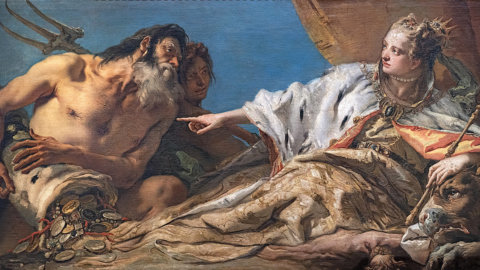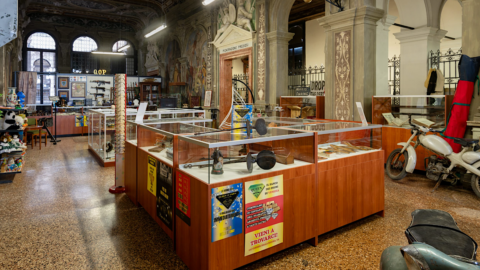VENETIA 1600. Births and rebirths, can be visited in Palazzo Ducale – Doge's apartment – until March 25, 2022.
The history of Venice is punctuated by multiple births and rebirths, concrete examples of how the city has always been able to face the challenges posed by the changing times. The exhibition features works by leading artists, architects and men of letters who worked in the lagoon for nearly a millennium. It is also an opportunity to admire masterpieces by Carpaccio, Titian, Veronese, Tiepolo, Canaletto, Guardi and many others, as well as a selection of miniatures, prints, drawings, textiles, sculptures, ceramics, architectural models, glassware and everyday objects.
Furthermore, particular attention is given to the most representative monuments of the city, such as the basilica of San Marco, the Palazzo Ducale, the Rialto Bridge, the Fondaco dei Tedeschi, the churches of the Redentore and Santa Maria della Salute, the Gran Teatro Fenice and the Campanile di San Marco, up to including the major museums and cultural institutions of contemporary Venice. In addition to the great masterpieces from Italian museums and private collections, the exhibition intends to enhance the priceless historical-artistic and cultural heritage of Venetian museums, churches, libraries and archives, first of all that of the collections of the Venice Civic Museums.
An exhibition and a series of events that narrate the great glories and successes of Venice up to the weaknesses that decreed the end in 1797. This was the period in which the city passed for almost twenty years from French to Austrian control, and vice versa. In 1807 Napoleon made his triumphal entry into Venice not from the sea, as was the tradition, but from the mainland. For the occasion, a majestic triumphal arch was erected in front of the church of Santa Lucia, a very prophetic place. Forty years later, it was in Santa Lucia that the station of the railway line that connected Venice to the mainland was built. No longer an empire, no longer independent, Venice was no longer even an island. When revolution swept across Europe in 1848, the Venetians drove out the Austrians and proclaimed the new Republic of San Marco, consisting of the city and many of its former mainland territories. But independence lasted only seventeen months. The Austrians reconquered the insurgent territories one by one, forcing the Venetian forces to fall back into the city. Although in April 1849 the assembly of the Republic had voted to resist "at any cost", the incessant bombing of the city, as well as famine and cholera, forced the Venetians to surrender in August. Another seventeen years of Austrian rule followed. Despite this, it was able to renew itself and already from the end of the 800th century, several institutions were bornavant-garde visual artsas was the case in the Renaissance. To this day, the Venice Biennale remains the oldest of these institutions and the most prestigious contemporary art exhibition in the world. After the Second World War, the American Peggy Guggenheim moved to the Lagoon with her collection exhibited at the XXIV Biennale (1948) and with the opening of her house, her museum (1951), still today a prestigious art museum from the twentieth century. In addition to promoting foreign painters such as Jackson Pollock, the Guggenheim supported many Venetian artists. Furthermore, Venice hosts the oldest film festival held on the Lido. Since 1980 also the Architecture Biennale, an international showcase of design and urban planning. Today the visual arts have become the backbone of a new economy for the city, which includes a wide range of public and private educational and cultural institutions almost in homage to that great painting by Giambattista Tiepolo where Neptune offers Venice the gifts of the sea (1756 -1758) – the magniloquence of its parties and the jubilation of its arts.
Venice is unique and there is probably no other city in the world that can boast an environment so rich in monuments. For centuries Venice was one of the largest and richest most refined European cities: crossroads of peoples and ideas. For a millennium, its particular governmental structure guaranteed its political stability, assuring it the title of Serenissima and fueling the envy of its merchants. This year Venice celebrates 1600 years since its legendary foundation in 421. Venice has survived so long, overcoming constant threats and reinventing itself and changing over time. The decisive events of its history, its monuments, the many artistic and historical treasures displayed in this exhibition still offer a useful roadmap for the future of the city.
Online booking of the exhibition ticket is recommended.
INFO: Telephone booking through Call center: 848082000 (from Italy); +39 041 42730892 (only from abroad) every day from 09:00 to 13:00 Booking by email: ordinivenezia@coopculture.it
Cover image: Giambattista Tiepolo – Venice receives the homage of Neptune – 1745-50





